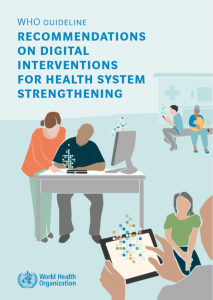
View Resource View Resource
The key aim of this guideline is to present recommendations based on a critical evaluation of the evidence on emerging digital health interventions that are contributing to health system improvements, based on an assessment of the benefits, harms, acceptability, feasibility, resource use and equity considerations. For the purposes of this version of the guideline, the recommendations examine the extent to which digital health interventions, primarily available via mobile devices, are able to address health system challenges along the pathway to UHC. By reviewing the evidence of different digital interventions against comparative options, as well as assessing the risks, this guideline aims to equip health policy-makers and other stakeholders with recommendations and implementation considerations for making informed investments into digital health interventions.
This guideline urges readers to recognize that digital health interventions are not a substitute for functioning health systems, and that there are significant limitations to what digital health is able to address. Digital health interventions should complement and enhance health system functions through mechanisms such as accelerated exchange of information, but will not replace the fundamental components needed by health systems such as the health workforce, financing, leadership and governance, and access to essential medicines. An understanding of which health system challenges can realistically be addressed by digital technologies, along with an assessment of the ecosystem’s ability to absorb such digital interventions, is thus needed to inform investments in digital health. Additionally, the adoption of the recommendations in this guideline should not exclude or jeopardize the provision of quality non-digital services in places where there is no access to the digital technologies or they are not acceptable or affordable for target communities.
The recommendations in this guideline represent a subset of prioritized digital health interventions accessible via mobile devices, and this guideline will gradually include a broader set of emerging digital health interventions over subsequent versions. This includes recommendations on the following topics:
-
birth notification via mobile devices
-
death notification via mobile devices
-
stock notification and commodity management via mobile devices
-
client-to-provider telemedicine
-
provider-to-provider telemedicine
-
targeted client communication via mobile devices
-
digital tracking of patients’/clients’ health status and services via mobile devices
-
health worker decision support via mobile devices
-
provision of training and educational content to health workers via mobile devices (mobile learning-mLearning)